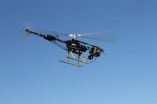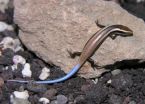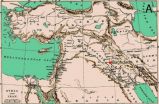(Press-News.org) WASHINGTON, April 30--Physicists have long chased an elusive goal: the ability to "freeze" and then study the motion of electrons in matter. Such experiments could help confirm theories of electron motion and yield insights into how and why chemical reactions take place. Now a collaboration of scientists from France and Canada has developed an elegant new method to study electrons' fleeting antics using isolated, precisely timed, and incredibly fast pulses of light. The team will describe the technique at the Conference on Lasers and Electro-Optics , taking place in San Jose, Calif. May 6-11. (CLEO: 2012 (http://www.cleoconference.org))
The exchanges of electrons during chemical reactions typically occur on time scales less than one femtosecond, or a millionth of a billionth of a second. The only way to freeze electron motion is using pulses of light with durations that are shorter still than the rapid comings and goings of electrons – on the order of quintillionths of a second, or attoseconds. Once they are frozen, "the dynamics of electrons could then be studied by so-called pump-probe experiments" that use a pair of light pulses, explains physicist Fabien Quéré of the French Commissariat à l'Energie Atomique (CEA). The first pulse – dubbed the pump – kick-starts the motion of the electrons at a well-defined starting time, he explains, "and the second one, the probe, looks at the excited system at different times after the pump, to measure its evolution after excitation."
Attosecond pulses have been produced through the interaction of ultra-powerful laser beams with matter. The resulting light bursts, however, come in "trains" – collections of pulses closely spaced in time – that don't work very well in pump-probe experiments. What would work far better are isolated and precisely-timed pulses. That's exactly what Quéré, along with graduate student Henri Vincenti and colleagues at the Applied Optics Laboratory (LOA, France) and the National Research Council of Canada (NRC), have created using a new method, dubbed the "attosecond lighthouse" effect.
In the technique, the initial laser beam is shaped in order to induce an ultrafast rotation of its wavefront, so that its interaction with matter produces a train of individual attosecond pulses that is streaked angularly – like the sweeping beam of a lighthouse. The researchers can thus generate a collection of beamlets, "each one consisting in the time domain, according to theory and simulations, of a single attosecond pulse," Quéré says – which produces an ideal light source for attosecond pump-probe experiments.
According to the researchers, the attosecond lighthouse effect has several major advantages over previous methods for making isolated attosecond pulses. For example, Quéré says, "it is by far the easiest one to implement experimentally. In practice, it only requires a very small rotation of one optical element – a prism or a grating, typically – in existing laser systems."
INFORMATION:
CLEO: 2012 presentation QTu3H.2, "Attosecond lighthouses," by Fabien Quéré et al. is at 4:45 p.m. on Tuesday, May 8 in the San Jose Convention Center. Quéré's team will also report on the first experimental demonstration of this effect during a CLEO: 2012 post-deadline paper presentation at 9:36 p.m. on Thursday, May 10.
EDITOR'S NOTE: High-resolution images are available upon request. Contact Angela Stark, astark@osa.org.
Press Registration
A Press Room for credentialed press and analysts will be located on-site in the San Jose Convention Center, May 6 – May 11. Media interested in attending the conference should register on the CLEO website (http://www.cleoconference.org/home/news-and-press/press-and-analysts/press-and-analyst-registration-form.aspx) or contact Angela Stark at 202.416.1443, astark@osa.org.
About CLEO
With a distinguished history as the industry's leading event on laser science, the Conference on Lasers and Electro-Optics (CLEO) is where laser technology was first introduced. CLEO unites the field of lasers and electro-optics by bringing together all aspects of laser technology, with content stemming from basic research to industry application. CLEO: Expo showcases the latest products and applications from more than 300 participating companies from around the world, providing hands-on demonstrations of the latest market innovations and applications. The Expo also offers valuable on-floor programming, including Market Focus and the Technology Transfer program.
Sponsored by the American Physical Society's (APS) Laser Science Division, the Institute of Electronic Engineers (IEEE) Photonics Society and the Optical Society (OSA), CLEO provides the full range of critical developments in the field, showcasing the most significant milestones from laboratory to marketplace. With an unparalleled breadth and depth of coverage, CLEO connects all of the critical vertical markets in lasers and electro-optics. For more information, visit the conference's website at www.cleoconference.org.
Attosecond lighthouses may help illuminate the tempestuous sea of electrons
2012-04-30
ELSE PRESS RELEASES FROM THIS DATE:
Portable gas sensors improve atmospheric pollution measurements
2012-04-30
WASHINGTON, April 30--Different types of compact, low-power portable sensors under development by three independent research groups may soon yield unprecedented capabilities to monitor ozone, greenhouse gases, and air pollutants. The three teams will each present their work at the Conference on Lasers and Electro-Optics (CLEO: 2012 (http://www,cleoconference.org)), to be held May 6-11, in San Jose, Calif.
Princeton University engineer Amir Khan and colleagues, working with space scientists at the University of Texas at Dallas, will discuss how their teams combined a compact, ...
24 new species of lizards discovered on Caribbean islands are close to extinction
2012-04-30
In a single new scientific publication, 24 new species of lizards known as skinks, all from islands in the Caribbean, have been discovered and scientifically named. According to Blair Hedges, a professor of biology at Penn State University and the leader of the research team, half of the newly added skink species already may be extinct or close to extinction, and all of the others on the Caribbean islands are threatened with extinction. The researchers found that the loss of many skink species can be attributed primarily to predation by the mongoose -- an invasive predatory ...
New research expands understanding of psychoactive medication use among children in foster care
2012-04-30
Philadelphia -- A few months after the federal Government Accountability Office (GAO) issued a report on the use of psychoactive drugs by children in foster care in five states, a national study from PolicyLab at The Children's Hospital of Philadelphia describes prescription patterns over time in 48 states. The updated findings show the percentage of children in foster care taking antipsychotics--a class of psychoactive drugs associated with serious side effects for children-- continued to climb in the last decade. At the same time, a slight decline was seen in the use ...
Agroforestry is not rocket science but it might save DPR Korea
2012-04-30
KOREA (30 April 2012) — There is more going on in DPR Korea than rocket science: local people in collaboration with natural resources scientists are taking control of their food supply through agroforestry. This is according to a report published in Agroforestry Systems journal.
How participatory agroforestry restored land and secured the food supply
The report published online on 24 March, notes that in DPR Korea a bottom–up participatory process of developing locally appropriate agroforestry has been a revelation to many and is helping to reverse the chronic food ...
Scientists uncover exciting lead into premature aging and heart disease
2012-04-30
Scientists have discovered that they can dramatically increase the life span of mice with progeria (premature ageing disease) and heart disease (caused by Emery-Dreifuss muscular dystrophy) by reducing levels of a protein called SUN1. This research was done by A*STAR's Institute of Medical Biology (IMB) in collaboration with their partners at the National Institute of Allergy and Infectious Diseases in the United States and the Institute of Cellular and System Medicine in Taiwan. Their findings were published in the prestigious scientific journal, Cell, on 27th April 2012 ...
Antarctic albatross displays shift in breeding habits
2012-04-30
A new study of the wandering albatross – one of the largest birds on Earth – has shown that some of the birds are breeding earlier in the season compared with 30 years ago.
Reporting online this month (April) in the journal Oikos, a British team of scientists describe how they studied the breeding habits of the wandering albatross on the sub-Antarctic island of South Georgia. They have discovered that because some birds are now laying their eggs earlier, the laying date for the population is an average of 2.2 days earlier than before.
The researchers say the reasons ...
Arabic records allow past climate to be reconstructed
2012-04-30
Corals, trees and marine sediments, among others, are direct evidence of the climate of the past, but they are not the only indicators. A team led by Spanish scientists has interpreted records written in Iraq by Arabic historians for the first time and has made a chronology of climatic events from the year 816 to 1009, when cold waves and snow were normal.
The Arabic historians' records chronologically narrate social, political and religious matters, and some of them mention climate. A study led by researchers from the University of Extremadura (Spain) has focused on ancient ...
Superconducting strip could become an ultra-low-voltage sensor
2012-04-30
Researchers studying a superconducting strip observed an intermittent motion of magnetic flux which carries vortices inside the regularly spaced weak conducting regions carved into the superconducting material. These vortices resulted in alternating static phases with zero voltage and dynamic phases, which are characterised by non-zero voltage peaks in the superconductor. This study, which is about to be published in EPJ B¹, was carried out by scientists from the Condensed Matter Theory Group of the University of Antwerp, Belgium, working in collaboration with Brazilian ...
Obesity affects job prospects for women, study finds
2012-04-30
Obese women are more likely to be discriminated against when applying for jobs and receive lower starting salaries than their non-overweight colleagues, a new study has found.
The study, led by The University of Manchester and Monash University, Melbourne, and published in the International Journal of Obesity, examined whether a recently developed measure of anti-fat prejudice, the universal measure of bias (UMB), predicted actual obesity job discrimination. The researchers also assessed whether people's insecurity with their own bodies (body image) and conservative personalities ...
Magnetic resonance imaging with side effects
2012-04-30
Great care should be taken when performing magnetic resonance imaging (MRI) in patients with a cardiac pacemaker. Henning Bovenschulte and his co-authors review recent findings in the latest issue of Deutsches Ärzteblatt International (Dtsch Arztebl Int 2012; 109[15]: 270-5).
MRI is generally contraindicated in patients with a pacemaker (PM) or an implantable cardiac defibrillator (ICD), because of the risk of life-threatening events. The devices and their sensors may interact with the magnetic fields, disrupting the cardiac rhythm. Energy builds up in the electrode leads, ...



